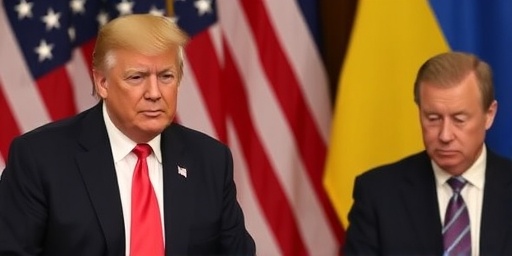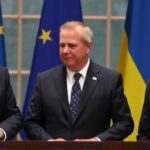In a surprising pivot that has reignited hopes and fears alike in the ongoing Russia-Ukraine conflict, President Donald Trump declared on November 22, 2025, that the White House’s ambitious 28-point Ukraine peace plan is far from set in stone. Speaking to reporters at the White House, Trump emphasized, “This is not my final offer—there’s room for negotiations.” The statement comes as the proposal, which demands Ukraine cede significant territory to Russia and forgo NATO membership, faces fierce opposition from lawmakers on both sides of the aisle, potentially reshaping the trajectory of one of the world’s most volatile geopolitical standoffs.
- Breaking Down the 28-Point Proposal’s Demands on Ukraine
- Bipartisan Lawmakers Slam Trump’s Plan as ‘Dangerous Giveaway’
- Russia Welcomes Opening but Demands More in Ukraine Talks
- Ukraine’s Defiant Stance and the Human Cost of Stalled Peace
- Path Forward: Potential Twists in Trump-Led Ukraine-Russia Negotiations
The announcement underscores Trump’s signature deal-making approach, injecting uncertainty into a plan that has already drawn sharp rebukes for appearing to favor Moscow’s interests. As Ukraine grapples with the devastating impacts of the war—over 500,000 military casualties reported by independent monitors and an economy shrunk by 30% since Russia’s full-scale invasion in 2022—the U.S. president’s words could signal a willingness to broker a compromise, or alternatively, a tactical maneuver to pressure Kyiv into concessions.
Breaking Down the 28-Point Proposal’s Demands on Ukraine
At the heart of the controversy is the detailed 28-point Ukraine peace plan, unveiled by the Trump administration earlier this month as a blueprint for ending the protracted conflict with Russia. The document, leaked in full to major outlets like The New York Times, outlines stringent conditions that have stunned observers for their boldness. Key among them is the requirement for Ukraine to recognize Russian control over Crimea and the Donbas region, territories seized or contested since 2014, effectively legitimizing annexations that the international community has long condemned as illegal.
Further stipulations include Ukraine’s permanent abandonment of NATO aspirations—a red line for Kyiv since its independence from the Soviet Union—and the demilitarization of its eastern borders. In exchange, the plan promises U.S. economic aid packages totaling $50 billion over five years, alongside security guarantees from a multinational force excluding NATO members. Trump, in his remarks, framed these elements as “practical steps toward stability,” arguing that “endless war benefits no one, especially not the brave people of Ukraine.”
Yet, the proposal’s territorial concessions have evoked painful historical parallels for Ukrainians, reminiscent of the Munich Agreement of 1938, where appeasement of aggressors led to greater calamity. Ukrainian President Volodymyr Zelenskyy, in a televised address hours after Trump’s statement, decried the plan as “a surrender disguised as peace,” vowing that “no amount of American pressure will force us to betray our sovereignty.” Statistics from the Kiel Institute for the World Economy highlight the stakes: Ukraine has received over $100 billion in Western aid since 2022, making U.S. leverage immense but not absolute.
Experts note that the 28 points also incorporate economic incentives for Russia, such as eased sanctions on energy exports, which could alleviate Moscow’s fiscal strains amid a war costing an estimated $200 billion annually. This multifaceted approach aims to entice both sides, but critics argue it disproportionately burdens Ukraine, a nation that has reclaimed over 50% of occupied territories through fierce counteroffensives in 2023 and 2024.
Bipartisan Lawmakers Slam Trump’s Plan as ‘Dangerous Giveaway’
The backlash in Washington has been swift and bipartisan, with senators and representatives from both parties uniting in condemnation of the Ukraine peace plan. Senate Minority Leader Chuck Schumer (D-NY) called it “a dangerous giveaway to Putin,” warning that conceding territory would embolden authoritarian regimes worldwide. On the Republican side, Sen. Lindsey Graham (R-SC), a longtime Trump ally, expressed rare dissent, stating in a Fox News interview, “This isn’t peace; it’s capitulation. We can’t ask Ukraine to fight for its freedom and then hand victory to Russia on a silver platter.”
House Speaker Mike Johnson (R-LA) has scheduled emergency hearings for next week, where foreign policy experts will testify on the plan’s ramifications. A poll conducted by Quinnipiac University on November 20 revealed that 62% of Americans oppose territorial concessions to Russia, with only 28% supporting the full 28-point framework. This public sentiment has amplified congressional pressure, as midterm elections loom and voters prioritize national security.
Democratic Rep. Adam Schiff (D-CA), a key voice on intelligence matters, introduced legislation to block any U.S. funding tied to the proposal unless Ukraine’s consent is explicitly obtained. “Trump’s negotiations can’t come at the expense of our allies,” Schiff argued in a statement. Meanwhile, progressive lawmakers like Rep. Alexandria Ocasio-Cortez (D-NY) have linked the plan to broader critiques of Trump’s foreign policy, accusing it of prioritizing isolationism over democratic values.
The unified front marks a rare moment of cross-aisle solidarity, reminiscent of the overwhelming support for Ukraine aid packages in 2022. However, Trump’s base remains divided: a Rasmussen Reports survey shows 55% of Republicans back his approach, viewing it as a pragmatic end to U.S. involvement in “Europe’s war.” This internal GOP tension could complicate negotiations, as Trump navigates loyalty from his supporters while fending off establishment critics.
Russia Welcomes Opening but Demands More in Ukraine Talks
From the Kremlin, the response to Trump’s overture has been cautiously optimistic, with Russian President Vladimir Putin signaling openness to further discussions on the Ukraine peace plan. In a state media address on November 23, Putin described the proposal as “a step in the right direction,” particularly praising the NATO exclusion clause. “We have always sought a negotiated settlement based on realities on the ground,” he said, alluding to Russia’s control over approximately 18% of Ukrainian territory as of late 2025.
Russian Foreign Minister Sergey Lavrov followed up with a diplomatic note to the U.S., proposing bilateral talks in Geneva next month to refine the 28 points. Insiders report that Moscow is pushing for additional concessions, including Ukraine’s neutrality in global alliances and reparations for alleged “Nazi-era” damages—rhetoric that echoes Kremlin propaganda. Russia’s economy, battered by sanctions that have slashed GDP by 15% since 2022, stands to gain immensely from any sanction relief, potentially unlocking $300 billion in frozen assets.
Yet, skepticism abounds in analytical circles. The Carnegie Endowment for International Peace warns that Russia’s history of bad-faith negotiations, as seen in the failed Minsk Agreements of 2014-2015, suggests the peace plan could be a stalling tactic. “Putin uses talks to regroup,” said senior fellow Eugene Rumer. Ukrainian intelligence echoes this, reporting increased Russian troop movements near Kharkiv, hinting at no immediate de-escalation.
International allies, including the UK and Germany, have urged caution. British Prime Minister Keir Starmer, in a joint statement with EU leaders, affirmed that “any deal must respect Ukraine’s borders as recognized by the UN,” rejecting territorial cessions outright. This transatlantic pushback underscores the delicate balance Trump must strike in his negotiations, where alienating Europe could isolate the U.S. further.
Ukraine’s Defiant Stance and the Human Cost of Stalled Peace
For the people of Ukraine, Trump’s words offer a glimmer of hope amid unimaginable hardship, but the peace plan’s demands have deepened national resolve. In Kyiv’s Independence Square, protests erupted on November 22, with thousands chanting “No Capitulation!” as veterans shared stories of loss. The war has claimed over 10,000 civilian lives, according to UN estimates, and displaced 6 million internally, creating Europe’s largest refugee crisis since World War II.
Zelenskyy’s government has mobilized public support through referendums and media campaigns, with 78% of Ukrainians opposing territorial compromises per a recent Kyiv International Institute of Sociology poll. Military analysts highlight Ukraine’s growing self-sufficiency: domestic drone production has surged 400% since 2023, reducing reliance on foreign arms. “We negotiate from strength, not weakness,” Defense Minister Rustem Umerov told CNN, emphasizing recent victories like the recapture of Zaporizhzhia.
The emotional toll is palpable in personal narratives. In Lviv, a mother of three, whose husband was killed in the 2022 Mariupol siege, told Reuters, “If America forces us to give up our land, what was his sacrifice for?” Such stories humanize the stakes, fueling global solidarity campaigns that have raised $20 billion in private donations for Ukraine.
Women’s rights advocates point to the plan’s oversight of gender impacts: over 25,000 cases of wartime sexual violence reported by the UN, with peace terms failing to address justice for victims. This gap has drawn ire from organizations like Amnesty International, which calls for inclusive negotiations involving civil society.
Path Forward: Potential Twists in Trump-Led Ukraine-Russia Negotiations
As the dust settles on Trump’s announcement, the road ahead for the Ukraine peace plan remains fraught with uncertainty. With negotiations potentially kicking off in early 2026, diplomats anticipate a multi-phase process: initial U.S.-Russia bilaterals, followed by trilateral talks including Ukraine, under UN auspices. Trump’s team, led by special envoy Keith Kellogg, has hinted at “creative compromises,” such as phased territorial autonomy rather than outright cession, to bridge divides.
Global markets are already reacting: European natural gas prices dipped 5% on news of possible sanction easing, while the Ukrainian hryvnia strengthened 2% against the dollar, buoyed by negotiation optimism. However, risks loom large—if talks collapse, analysts from the Atlantic Council predict escalated Russian offensives, potentially drawing in NATO peripherally.
Looking ahead, the plan’s fate could influence U.S. midterm dynamics, with Trump leveraging any breakthrough as a foreign policy win. For Ukraine, bolstering alliances with non-NATO partners like Turkey and India offers alternative security nets. Ultimately, the success of these negotiations hinges on balancing power realities with moral imperatives, determining whether 2026 brings fragile peace or renewed conflict in Eastern Europe.
In the broader context, Trump’s flexibility signals a potential thaw in U.S.-Russia relations, frozen since the 2016 election interference scandals. Yet, with cyber threats and hybrid warfare escalating—Russia-linked hacks on Ukrainian infrastructure up 30% this year—the path to lasting stability demands vigilance. Stakeholders from Washington to Kyiv and Moscow will watch closely, as the world holds its breath for the next move in this high-stakes diplomatic chess game.









